Day 1: Arrive at Kathmandu, Nepal by your scheduled flight – this itinerary assumes an arrival in the late morning or early afternoon. You are greeted as you enter the arrival hall after collecting your baggage and driven to your lodge and assisted with your check-in at Kathmandu’s finest luxury lodging. This boutique lodge has wonderful facilities, a great location, and amazing service.
If your arrival at your lodge is a little before 3 pm, an early check-in may be possible, but is not guaranteed. For most of our South Asian destinations, we recommend a day at leisure upon arrival so as to both recuperate from your international flights, as well as to build a cushion for unexpected flight delays.
As all Nepal bound flights originating from the United States connect at least once, and most of them arrive in Kathmandu in the morning or very early afternoon, we schedule your arrival day as your day of leisure. For guests who are certain that they will want to explore on this day, your Guide can be available to explore Kathmandu if you let us know during your tour reservation process.
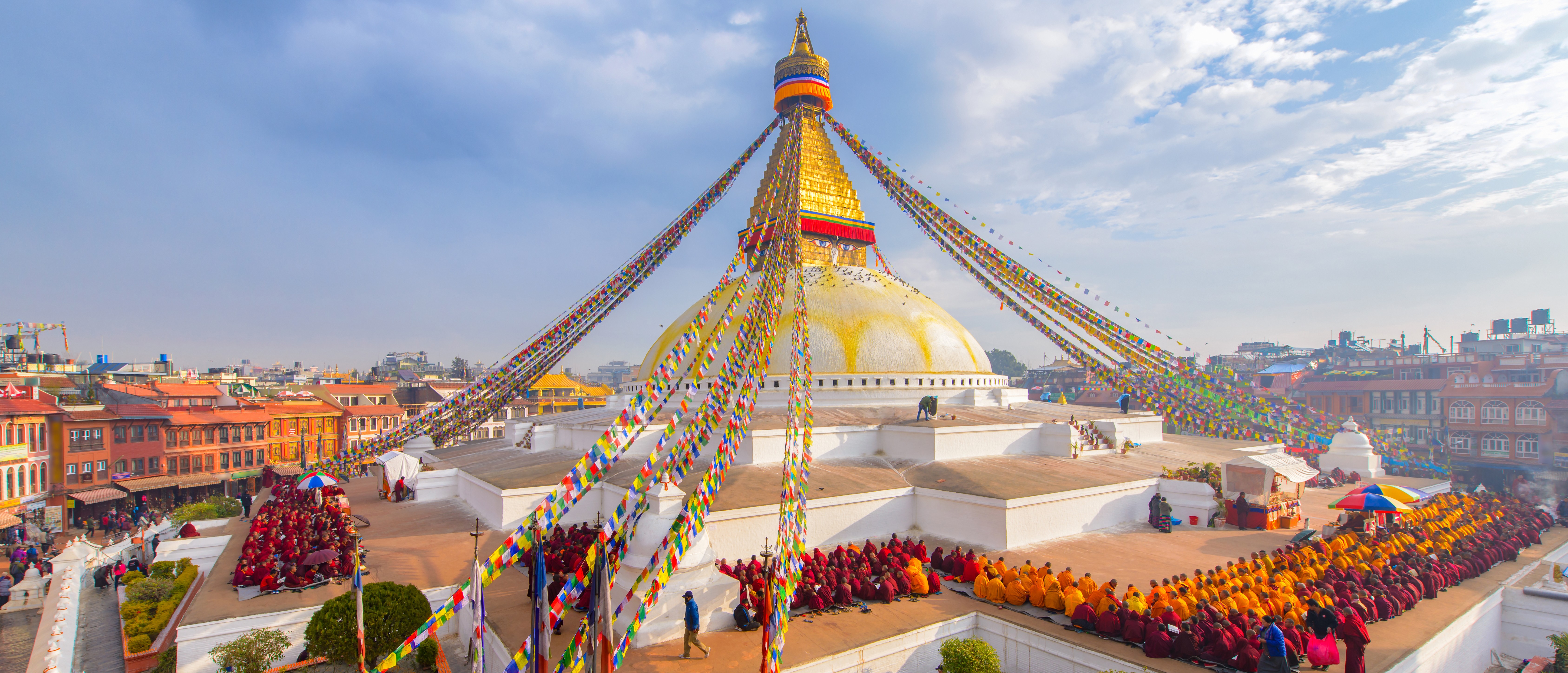
Boudhnath Stupa Morning Prayer
Welcome to an ancient Himalayan Country that offers a fascinating culture, incredible scenery, very warm and friendly people, great trekking opportunities, and a whole lot more. With the exception of the fairly congested Kathmandu Valley, Nepal has charming and laid-back cities and towns, along with picturesque wildlife parks that are home to many endangered species.
(Overnight - Dwarika's Hotel)
Day 2: Kathmandu. (Breakfast) Weather permitting, if you selected it, you will experience your Everest flight this morning with private assisted transfers between the lodge and the airport. If weather conditions result in the flight getting cancelled, it can be substituted for the following day.
Begin your exploration of the ancient Kathmandu valley with a tour of Pashupatinath Temple, a UNESCO World Heritage Site and one of the most sacred Hindu shrines in the world. Originally built around 2400 years ago, the spectacular temple was reconstructed by a Nepalese king in the 15th century after the original wooden structure was (purportedly) consumed by termites. A lesser-known fact among western visitors is that Nepal’s natives are primarily Hindus (over 80%), and Pashupatinath’s surrounding area is dotted with ancient Hindu shrines and ashrams, as well as a steady stream of pilgrims and worshippers.
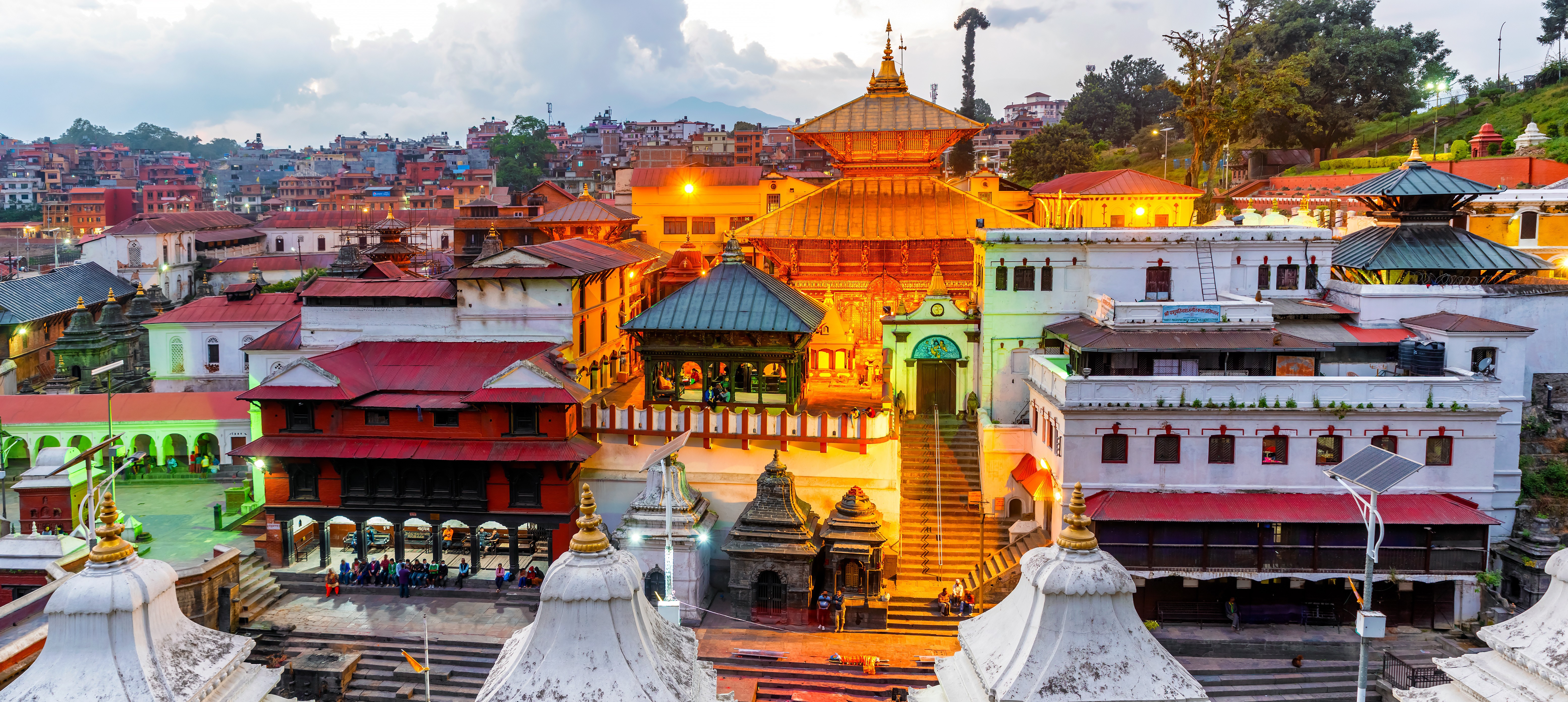
Pashupatinath Temple
Nepal’s holy river Bagmati flows through here and its banks are constant witnesses to Hindu ceremonies for the dead and the living. There is a cremation area where pyres are always present, and your Guide will ask you for a mindful approach in these areas. The main temple and most of the surrounding shrines received no damage in the 2015 earthquake.
Next you will experience a tour of Patan City, one of the three queen cities of the valley. Another UNESCO world Heritage Site, although some structures here were damaged or destroyed by the 2015 earthquake, much of the amazing historic site remains, and is more than well worth a visit. Patan is the city of fine arts, and you will start with an exploration of the Durbar Square. The museum here houses a collection of ancient bronzes and religious objects. Other noteworthy monuments are the impressive carvings at the 17th century Krishna Mandir and Mahavihar, and the 12th century Temple of the Buddha.
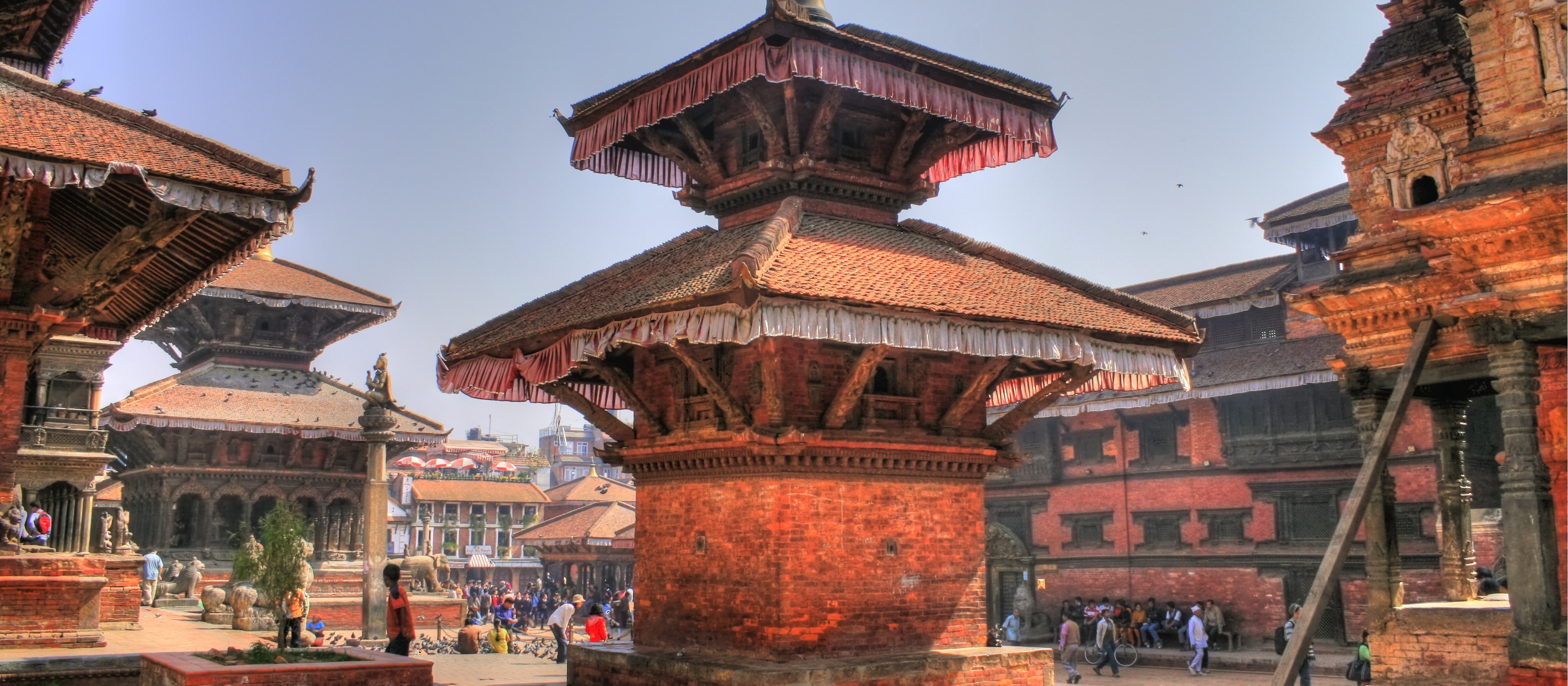
Patan Queen City Square
Your last experience today is a visit to the Swayambhunath Temple and Pagoda, Kathmandu’s signature monument, with the expressive eyes and nose painted on all four sides of its unique crown that are visible from almost all the Kathmandu Valley. With a history that may go back as far as 2500 years, this ancient complex is obviously a UNESCO World Heritage Site and is built on a hilltop.
Devout Nepalese walk up the hill from the base (365 steps), but most of our guests prefer to drive up almost all the way up and then use the few steps on the other side of the hill. Although a couple of the smaller surrounding monuments were damaged during the 2015 earthquake, the main structure still stands, along with other smaller shrines and monasteries surrounding it.
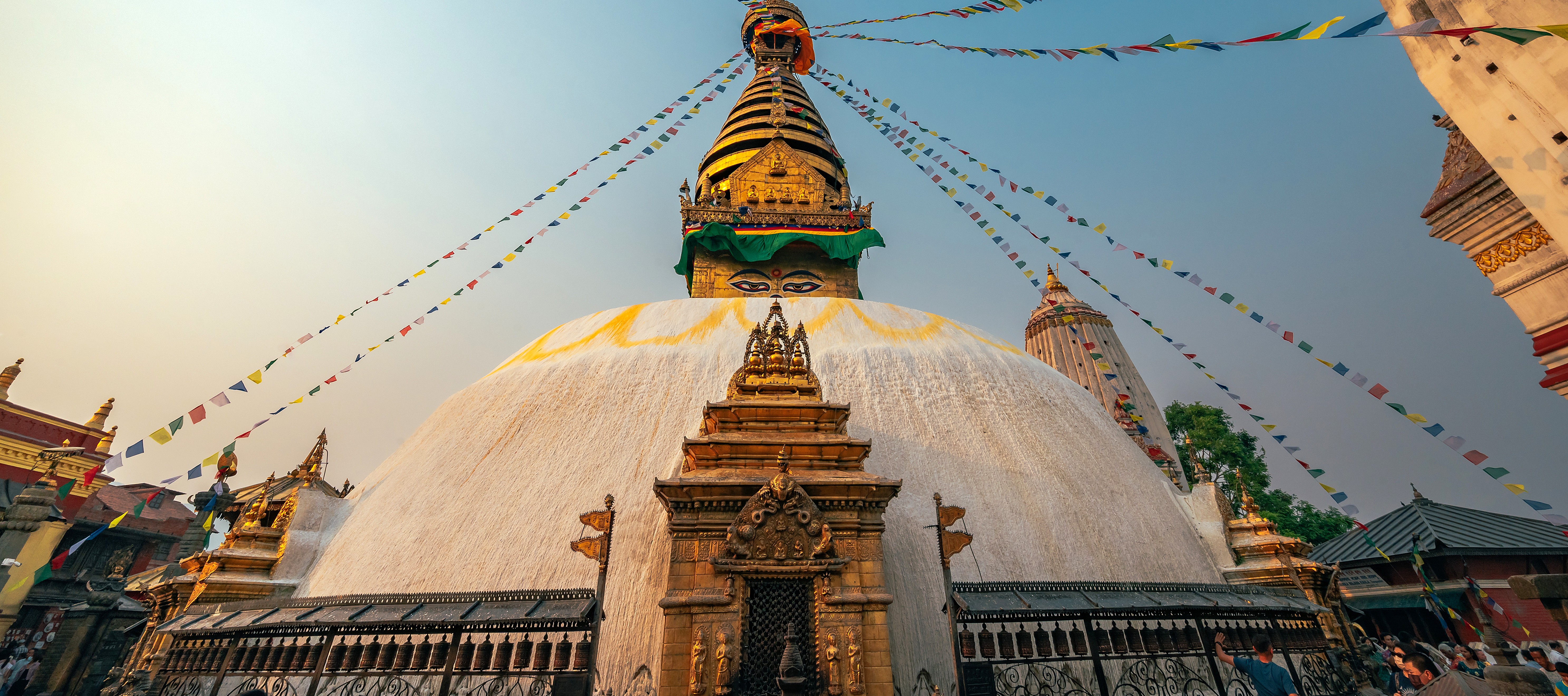
Swayambhunath Pagoda
(Overnight - Dwarika's Hotel)
Day 3: Kathmandu. (Breakfast) Continue your tour of Kathmandu city with the Boudhanath Stupa, a UNESCO World Heritage Site that is one of Kathmandu’s two landmarks. This is the largest stupa in Nepal and a major pilgrimage destination for Buddhists. Said to have been built just after Lord Buddha’s departure from the world about two and a half millennia ago, the stupa has multiple legends associated with it in both Nepalese and Tibetan Buddhism. The influx of Tibetan Buddhists escaping China’s control over the last six decades has transformed the area around it as many of them have settled here, and have also built over 50 Gompa’s (monasteries) around the Stupa. Exploring the stupa and its colorful surrounding areas is a highlight for any visitor to Kathmandu. The spire of the stupa and a few other areas received some damage in the 2015 earthquake but this has now been repaired.

Boudhanath Stupa
After the Stupa you will enjoy a walk in Thamel, the main bazaar area of Kathmandu. Thamel is also where a lot of the inexpensive hostels and other budget lodging options are located, and its colorful alleys are always abuzz with activity. Locals and backpackers flock to this area to shop for a vast range of products, from daily requirements to souvenirs, from clothing to footwear to toys. There are also a large number of dining and street food options for the backpackers, ranging from local Nepalese delicacies to western fare.
After breaking for lunch, you are driven to the Kathmandu Durbar Square, another UNESCO World Heritage Site. A few of the ancient monuments here were damaged during the earthquake, but much of it remains intact. The monuments in the Square were built between the 12th and 18th centuries, and this is where, even today, most of the state ceremonies are performed.
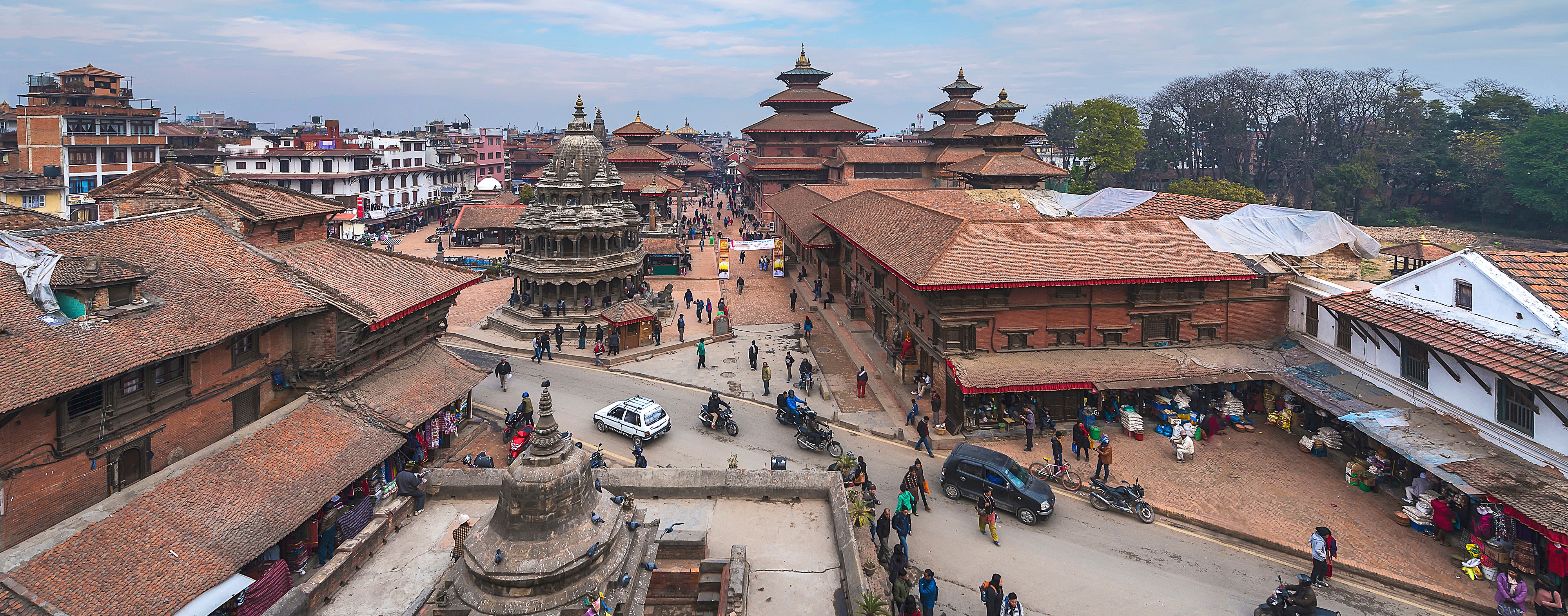
Durbar Square Kathmandu
Start with a visit to the beautiful 17th Century three-story building called Kumari Ghar, which means the abode of the Living Goddess. Guests may want to spend a couple of minutes researching this ancient tradition before their visit. If you are fortunate, you may be graced with the anointed child’s appearance in an upstairs window. You will then explore the ancient square and its many monuments, with the opportunity to pose in front of Kal Bhairav, an ancient and impressive stone relief of Lord Shiva in one of his most fearsome manifestations.
(Overnight - Dwarika's Hotel)
Day 4: Kathmandu – Pokhara. (Breakfast) You are assisted with your checkout in the morning and driven to the Kathmandu airport and assisted with boarding your short flight to the spectacular Annapurna Region.
Arrive at Pokhara and you are driven to your Himalayan lodge and assisted with your check-in to your charming room with its wonderful views. Recently constructed and top-ranked, Dorje’s Resort is nestled in the heart of Nepal's scenic wonderland and located strategically to offer panoramic views of the majestic Annapurna mountain range and the serene Phewa Lake, provides an idyllic setting for both adventurers and those seeking tranquility.
The architecture of Dorje's Resort is a thoughtful blend of traditional Nepalese design and modern luxury and the resort operates on principles of eco-friendliness and sustainability, utilizing solar energy, rainwater harvesting, and organic gardening practices. The resort offers a range of activities such as Himalayan spa treatments to morning yoga sessions on the terrace overlooking the mountains.

Annapurna Range View
The Annapurna Region is the land of the Magars and Gurungs, hardworking farmers and fierce warriors who have earned worldwide fame as Gurkha soldiers, and who are your guides in case you opt for treks in the Himalayan Annapurna Range. The British Army has long recruited soldiers from this region, and continues to do so today. The Gurkha soldiers serve in the British army, and can then either retire in the United Kingdom with full benefits and a pension, or choose to return to Nepal.
Pokhara is an area of lakes and mountains, and the valley and surrounding Himalayas offer some of the world’s best trekking, paragliding, and hand gliding. There is kayaking and white-water rafting, zip lining, the Pokhara Ultralight (for a unique gliding experience), mountain biking, and a whole lot more. This itinerary includes a day where our guests are at leisure to relax, or have us include one or more of the above-mentioned activities.
Extended stays can easily be facilitated for adventure activities. Pokhara is a part of most Nepal trekking itineraries, as much of that occurs in the Himalaya’s surrounding the Pokhara valley. A very popular gentle trekking itinerary includes the treks that used to be called the Sanctuary Lodge treks. These can be overnight (with 1 lodge) or multiple nights (with more lodges). The treks are 3 to 4 hours a day of not too strenuous walking, with spectacular views, charming pastoral stops at unique Gurkha villages, and a lot more.
(Overnight – Dorje’s Resort & Spa)

Pokhara Region
Day 5: Pokhara. (Breakfast) Given below is a suggested itinerary for a Pokhara exploration. You can make changes with your guide’s input, or choose part of the day and a nature hike.
Peace Pagoda (Shanti Stupa) - Start your day with a morning hike or drive up to the Peace Pagoda. This stunning stupa offers panoramic views of the Annapurna range, Lake Phewa, and the city of Pokhara below. It's a peaceful place to enjoy the sunrise and the natural beauty of the area.
Davis Falls - Next, head to Davis Falls, a unique waterfall that flows directly into a deep and narrow canal. The site has an interesting legend associated with it and is a popular spot for visitors.
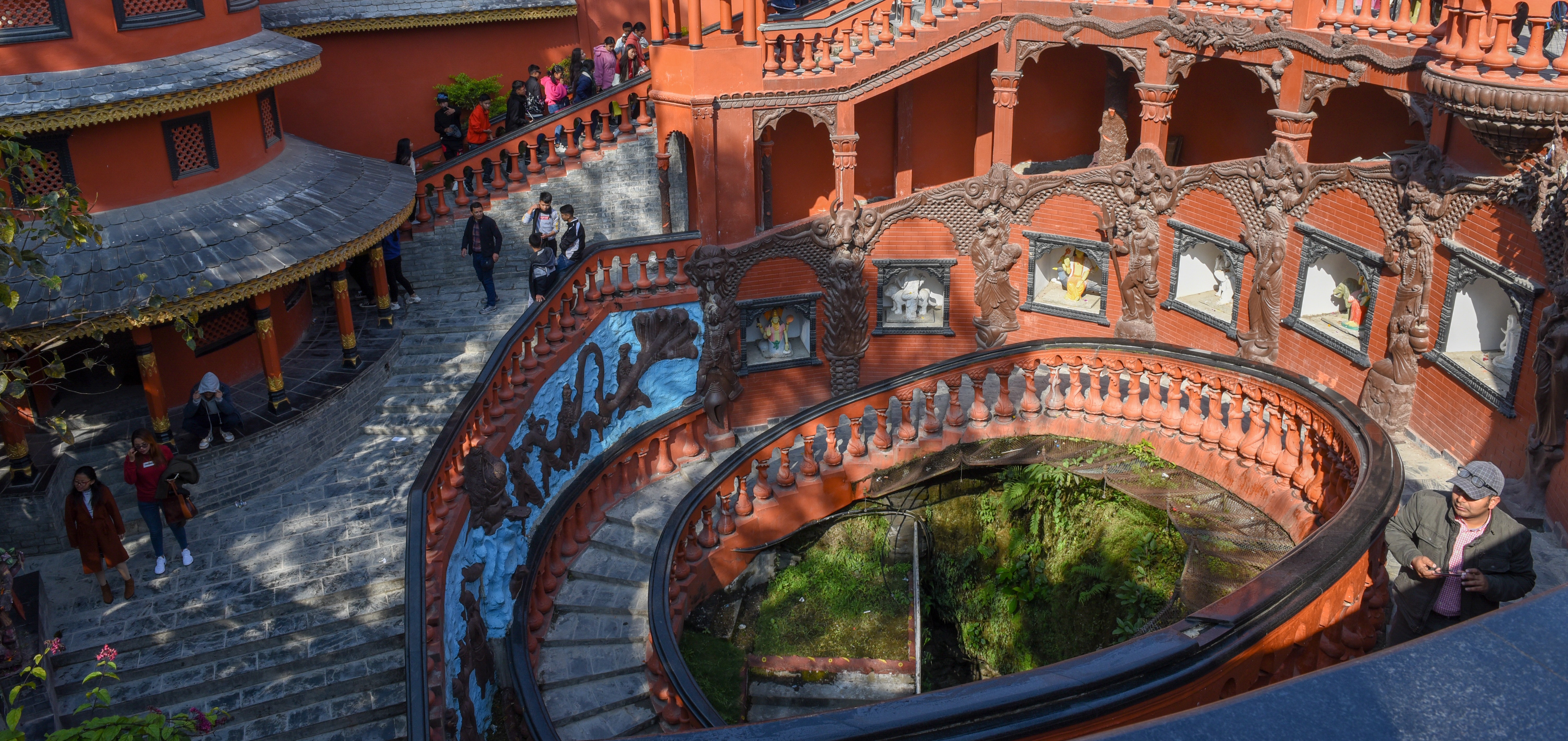
Gupteshwor Mahadev Cave Enrrance
Gupteshwor Mahadev Cave - Just across from Davis Falls, visit the sacred Gupteshwor Mahadev Cave, which houses a shrine dedicated to Lord Shiva. The cave also offers a view of the water rushing through its subterranean depths from Davis Falls.
Seti River Gorge - View the spectacular gorge carved by the Seti River, visible from several points throughout the city. The river runs deep below the surface, with some spots only a few meters across, yet impressively deep and narrow.
Old Pokhara and Bindhyabasini Temple - In the afternoon, explore the old bazaar of Pokhara, a traditional and colorful area, and visit the Bindhyabasini Temple, one of the oldest temples in the city, dedicated to Goddess Bhagwati.
Late Afternoon Boat Ride on Phewa Lake - Conclude your tour with a relaxing boat ride on Phewa Lake, the second largest lake in Nepal. Enjoy the serene water, view the reflection of Mount Machhapuchhre and other mountain ranges, and maybe even visit the island temple of Tal Barahi.
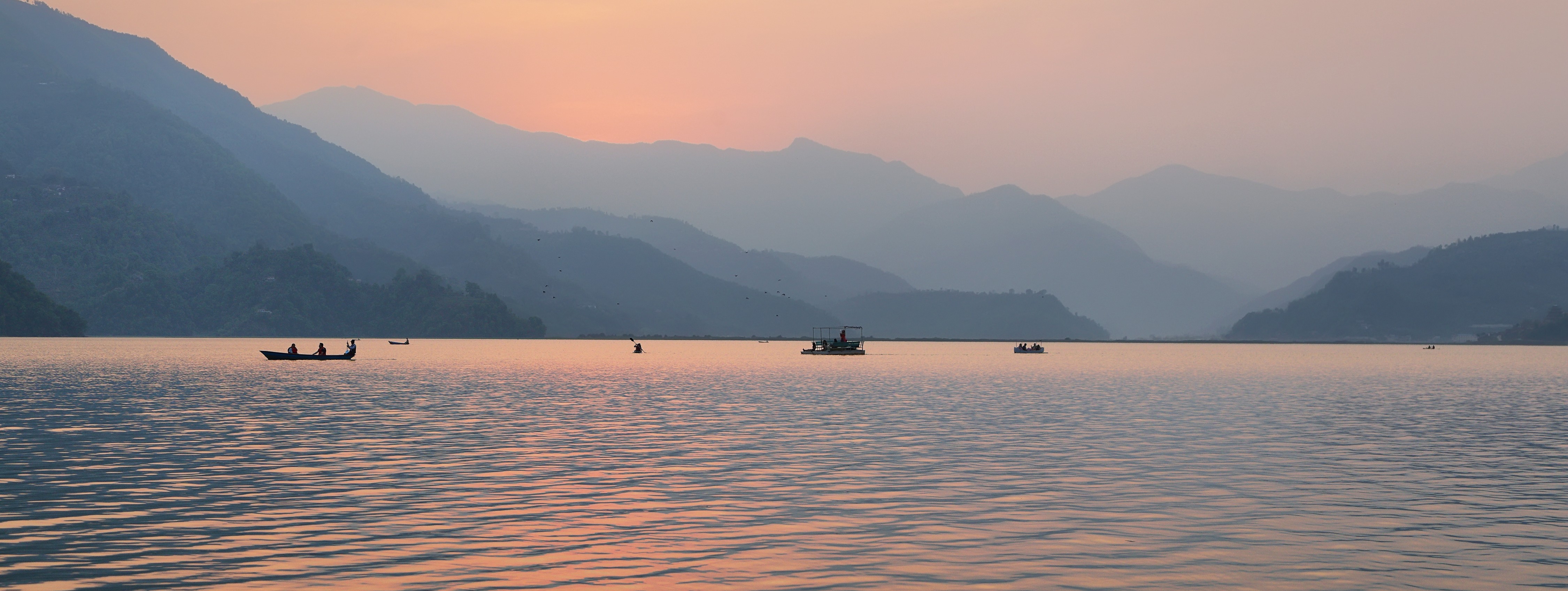
Phewa Lake at Sunset
Sunset at the Lakeside (or from your lodge) - End your day by walking along the Lakeside or enjoying a break at one of the lakeside cafes while watching the sunset over the lake.
(Overnight – Dorje’s Resort & Spa)
Day 6: Pokhara – Kathmandu - Dhulikhel. (Breakfast) You are assisted with your checkout in the morning and driven to the Pokhara airport and assisted in boarding your flight to Kathmandu. Your flight may offer you spectacular views of the tallest Himalayan Ranges. Upon arrival you are driven to Bhaktapur, a UNESCO world Heritage Site, for a guided exploration.
Bhaktapur lies on the way between Kathmandu airport and Dhulikhel and is a UNESCO World Heritage Site. It is one of the Kathmandu Valley’s three queen cities, and its name translates as The City of Devotees. The architecture and culture here is different from what you will experience in most of Kathmandu, as ancient Newari architecture and culture are found here in their purest form.
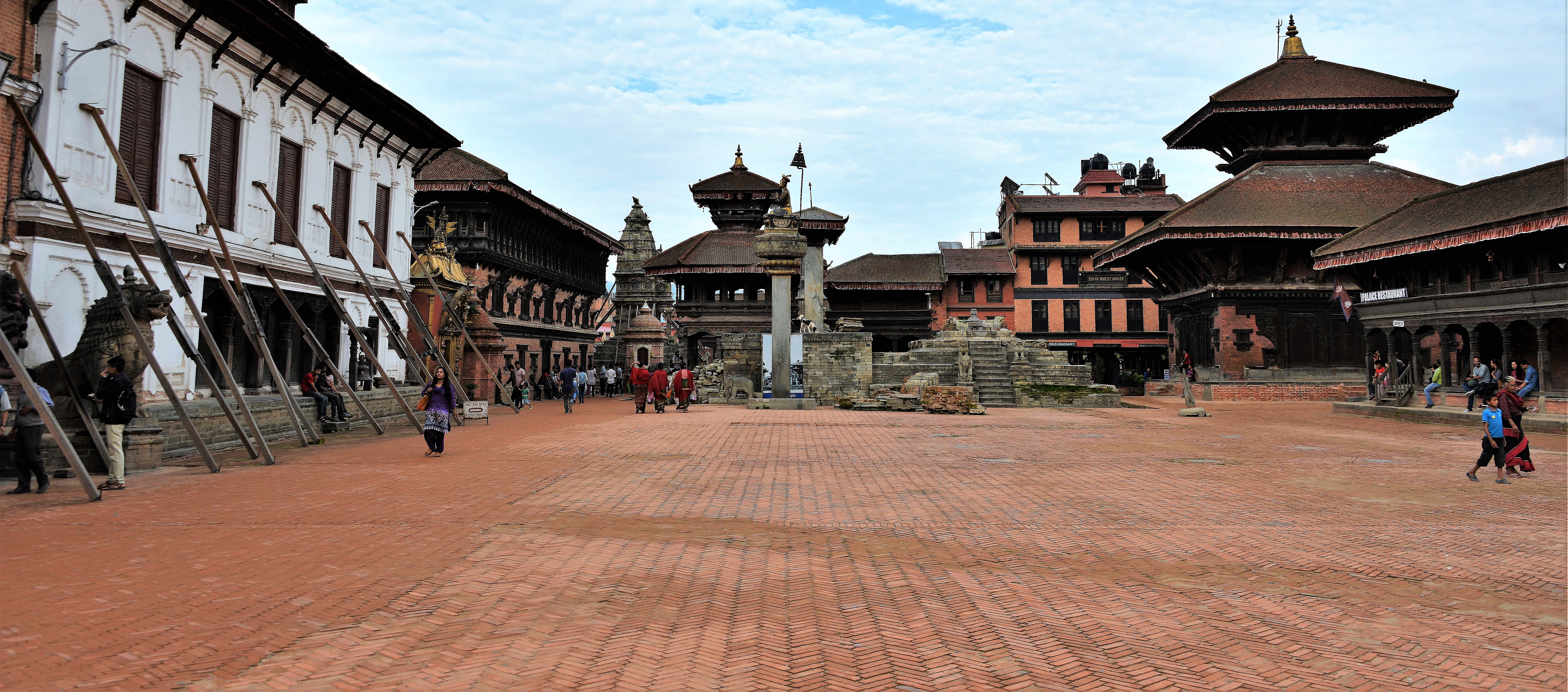
Bhaktapur Durbar Square
After this you will continue on with your hour and a quarter journey to the ancient mountain town of Dhulikhel. Arrive at your boutique luxury mountain resort and you are assisted with your check-in. Our guests universally recommend additional time at this resort.
For wellness, the resort offers a variety of wonderful packages and your Easy Tours Concierge can provide you with information after you have reserved your tour. The following activities are included as part of your suite’s benefits as per the resorts usual policies, but Easy Tours does not guarantee any of these activity’s will be available during your stay:
-Use of Himalayan Salt Room
-Use of Crystal House
-Use of Chakra Sound Therapy Chamber
-Use of Meditation Maze
-Use of Garden of Nine Planets
-Group Yoga Session
-Group Meditation Session
-Group Pottery Session
-Group Cine Therapy Session
-Visit to the farm
-Art and Painting Session
-Consultation with Ayurvedic Doctor
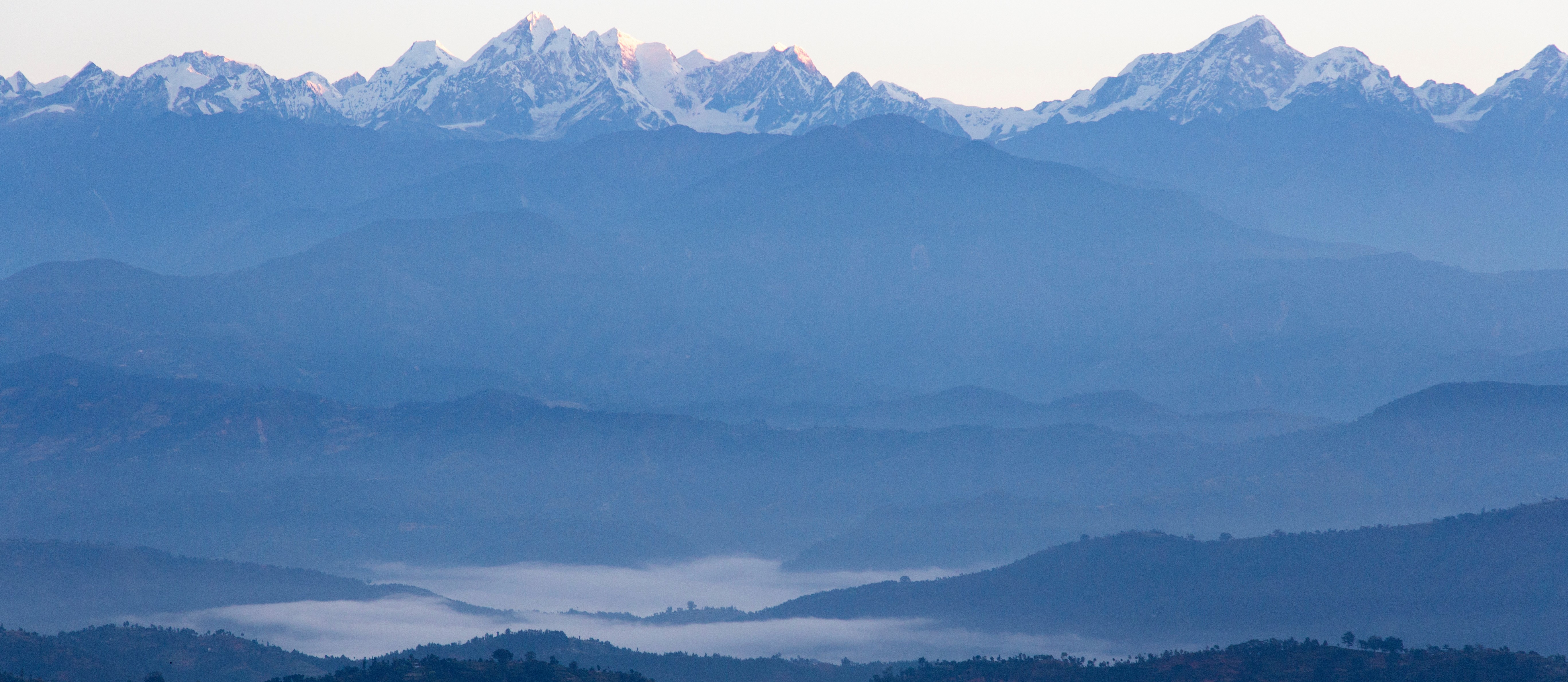
Himalayas at Sunrise from Dhulikhel
The scenic town of Dhulikhel has been an important trading post between the Kathmandu Valley and Tibet for many centuries and the views of the Tibetan and Nepalese Himalayas have to be seen to be believed. Over twenty of the tallest peaks of the Himalaya’s can be seen from different vantage points in the town, including Mt. Lhotse (8516 m – 27939 ft) and the spectacular Annapurna (8091 m – 26545 ft). Please note that the best time for good visibility of the distant Himalayas is at sunrise.
(Overnight - Dwarika's Resort)
Day 7: Dhulikhel. . (Breakfast) Historical Walk (or drive). The air is fresher and cooler here, and the pace of life noticeably slower. Start your tour with a walk through the old town, which is a living museum of Newari culture. The narrow cobbled lanes flanked by age-old houses with intricately carved wooden windows and doors are a photographer's delight. You can visit the Harisiddhi Temple and the Narayan Temple, both fine examples of traditional Newari architecture, featuring richly ornamented wooden carvings that depict various deities and mythical creatures.
Continuing your exploration, head towards the Gaukhureshwor Temple. This site offers a fantastic blend of spiritual and natural beauty, situated as it is at the edge of a hill with panoramic views of the lush surroundings. The temple itself, dedicated to Lord Shiva, showcases classic tiered pagoda architecture.

View from Dhulikhel
When you decide to break for lunch, we recommend traditional Newari cuisine as it is renowned for its variety and flavor, heavily influenced by both Indian and Tibetan culinary styles. Must-try dishes include "Bara" (savory rice pancakes), "Momos" (dumplings), and "Yomari" (sweet rice dough filled with jaggery and sesame seeds).
Post-lunch, take a short drive to the Kali Temple, positioned on a hilltop offering expansive views of the Himalayan ranges. The walk up to the temple is refreshing and invigorating. The panoramic vistas from here include a breathtaking view of peaks like Langtang, Gaurishankar, and even Mount Everest on clear days.
As the afternoon wanes, you can choose to visit the local museum that houses artifacts and displays illustrating the rich history and culture of the region. Here, you can learn about the town's significance in trade, culture, and religion throughout the centuries. No visit to Dhulikhel is complete without experiencing a sunset from one of its many vantage points. The Dhulikhel Viewpoint is a popular spot where you can see the sun setting behind the rolling hills, casting a golden glow over the Himalayas.
(Overnight - Dwarika's Resort)
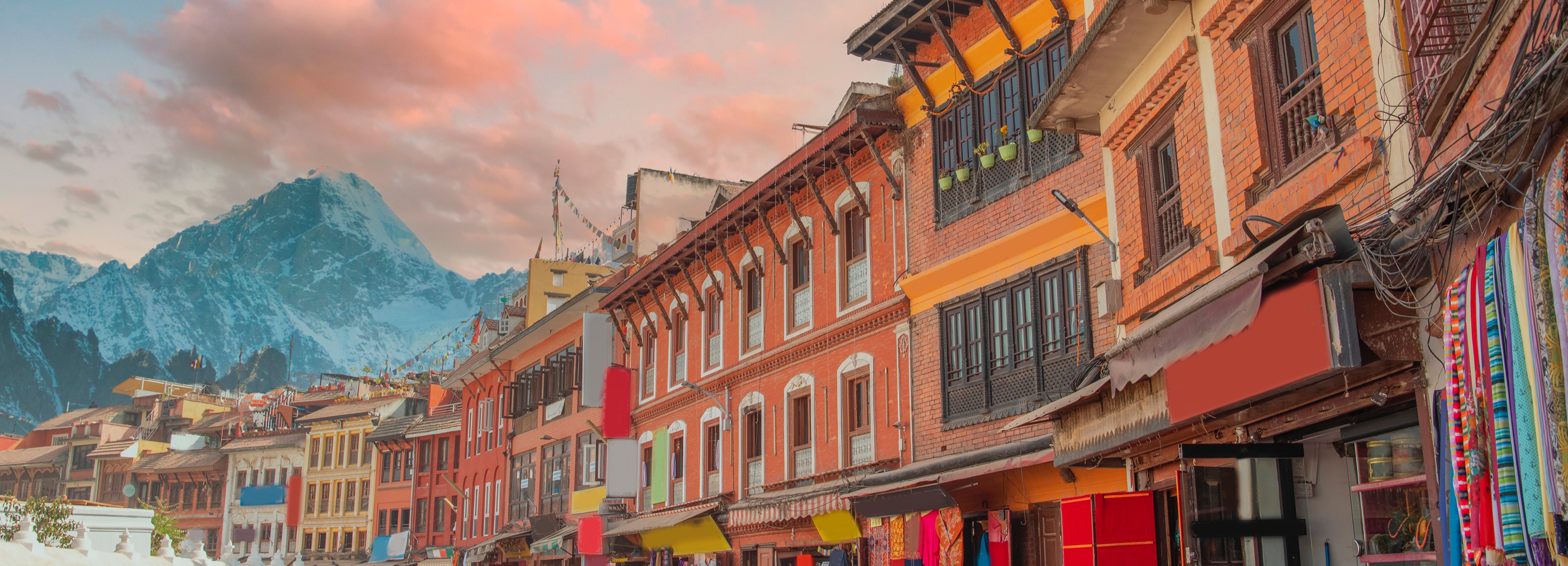
Buidings surrounding Boudanath Stupa
Day 8: Dhulikhel – Kathmandu Airport - International Flight. (Breakfast) You are assisted with your check-out from your lodge by noon and driven to the airport for your international flight. Those departing later in the day, or at night, can ask us to reserve an additional day of lodging and any other services they may want. At the airport you will be introduced to your Airport VIP Services Representative who will escort you through the check-in process and then through customs and immigration, all the way until your boarding process begins.
Our services end at Kathmandu Airport.



